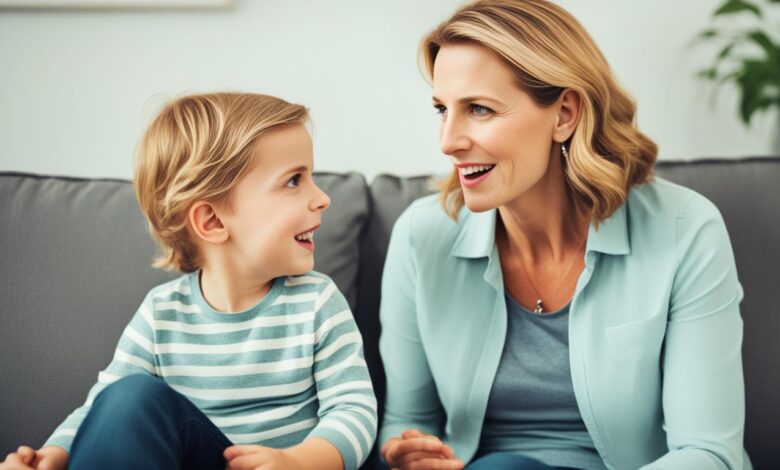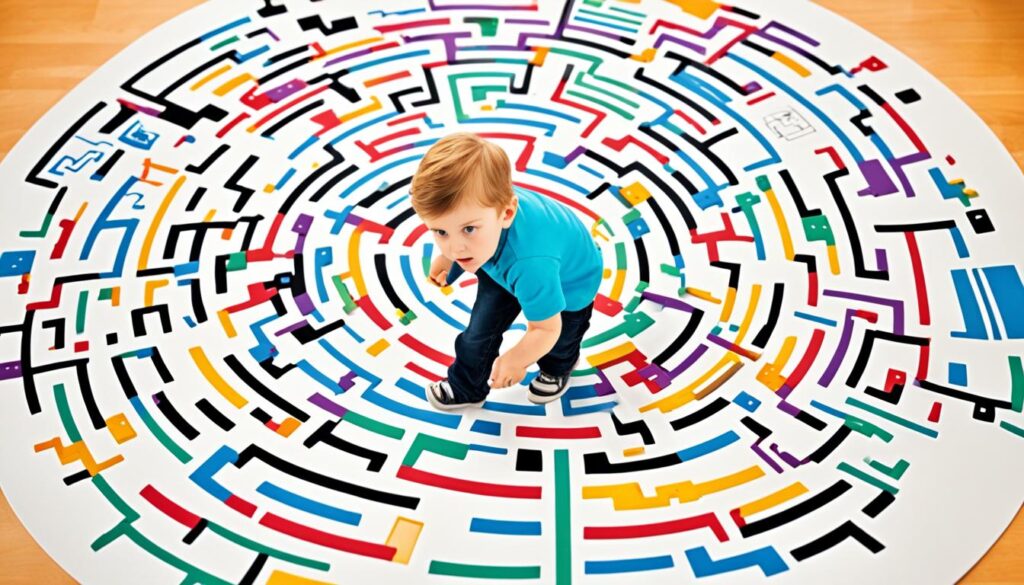Navigating ADHD: What to Say (and Not Say) to Your Kid

Words can be powerful, especially when parenting a child with ADHD. They can either smooth out a rough day or make things tougher. It’s crucial to find effective communication strategies for ADHD. This means knowing what to say (and not say) to your child about their ADHD. It’s a mix of cheering them on and guiding them right.
Support from a parent means breaking down walls that stop our kids’ growth. Helping them deal with ADHD with courage is hard. But we try our best to make our talks helpful and caring. Together with our kids, we face this challenge. We aim to bridge gaps of confusion with understanding and patience.
Even if we slip up sometimes, we learn and get better, all because we love. Encouragement and connection are key. Let’s blend support with understanding as we learn the best ways to talk, sensitive to our child’s feelings. Their world is full of life yet can be too much for them.
When figuring out what to say and skip, remember: your words are filled with love. In learning to communicate, it’s about teaching the right steps for a promising future, not just steering clear of errors.
Understanding Your Child’s ADHD Experience
When you start talking to children with ADHD, you must understand their unique viewpoints. This understanding helps us look past their immediate actions. It brings us closer to the neurological reasons behind ADHD. We will explore these reasons and find ways to grow developing compassion and improve ADHD communication tips.
Recognizing Neurological Explanations for ADHD Behaviors
In the core of ADHD communication tips, we learn that ADHD children act out because their brains work differently. Their brains have a hard time with staying focused and controlling impulses. This leads to impulsiveness and varied emotional responses. Knowing this, you understand their actions aren’t on purpose. With this insight, you’ll find the right approaches to meet their real needs.
Developing Compassion by Understanding ADHD
Understanding leads to compassion. As parents learn about the neurological causes of ADHD, they start to feel empathy instead of irritation. Knowing the details of ADHD allows for a helpful home where parents can use good ADHD communication tips. This kind of talk builds a positive setting for kids. It helps them see their actions clearly and find ways to manage ADHD with your support.
What to Say (and Not Say) to Your Kid About Their ADHD
Talking to your kid about ADHD is crucial for their growth. It helps them learn to manage their condition on their own. Instead of using negative words, talk in a way that makes them feel responsible. This helps them make decisions and grow.

What to say: It’s good to talk about ADHD in a positive way. Say things that show you believe in them. For example, “I’ve noticed how well you focused during your homework today.”
Avoiding negative phrases: Try not to say things that might sound discouraging. Don’t ask, “Why can’t you pay attention?” Say something like, “I see focusing is hard for you. Let’s think of ways to make it easier.”
Encouraging open dialogue about ADHD means more than just talking. It means listening carefully too. Let your child share their thoughts. This shows you value what they say.
Aim to validate their feelings by reflecting back: “It sounds like you were really overwhelmed by all the noise in the classroom. What do you think could help you concentrate better next time?”
Talking about ADHD with your child involves care in what you say and how you listen. Every word and silence can help them become stronger and better at handling challenges.
Effective Communication Strategies for ADHD
Working well with kids with ADHD means building a good relationship is crucial. Using effective communication strategies for ADHD helps improve the bond between parent and child. This makes sure both sides feel listened to and understood. It’s crucial to focus on how things are said, not just what is said, to build fostering connection.
Alternate Phrasing That Fosters Connection
Using alternate phrasing can turn a possible fight into a helpful talk. By offering choices instead of commands and observations instead of criticism, parents can lead their kids towards positive actions without resistance. For example, swapping “Don’t be so disorganized” for “How can we make organizing fun?” avoids negative comments. It also encourages the child to think creatively. This method aims at using a friendly tone that encourages working together.
Question Techniques to Enhance Self-Awareness
Improving self-awareness in kids with ADHD means asking the right questions. Instead of using direct questions that might seem like blame, asking open-ended questions helps kids think about their actions. Questions like “What do you think caused your reaction?” instead of “Why did you do that?” let kids calmly consider their actions. This method is respectful and helps kids understand their reactions better.
Encouraging Adaptable Thinking in Conversations
Adaptable thinking is key for kids with ADHD, aiding them in changing unhelpful habits. By involving them in discussions about different ways to tackle problems, you encourage flexible thinking. Asking “What’s another way we could approach your homework to make it easier?” helps the child explore various options. This improves their ability to solve problems effectively.
Patient, empathetic, and open-minded communication is essential when talking to children with ADHD. These strategies don’t just better communication; they also strengthen the parent-child relationship. They lay a solid foundation for trust and a deep, lasting connection.
Supporting Your ADHD Child without Enabling
Helping kids with ADHD is tricky for parents. The goal is to avoid doing too much for them while still providing needed guidance. It’s about making sure they feel supported but also pushed towards taking care of themselves. Finding this balance means understanding what your child needs and setting goals that encourage independence.

One good way to promote self-reliance is by establishing daily routines. These routines should become a normal part of life, not just things done to make parents happy. Kids then start taking charge of their actions and habits. This helps them learn how to manage themselves and grow as individuals.
| Conventional Instruction | Independence-Oriented Reframing |
|---|---|
| “I want you to clean your room now.” | “It’s time to manage your space for the day.” |
| “Why haven’t you done your homework?” | “What’s your plan for completing homework tasks today?” |
| “Stop fidgeting during meals.” | “Meals are a good time to practice calm seating.” |
The way we talk to kids matters a lot, as the table shows. By framing commands differently, kids are encouraged to be in charge of their choices. This method doesn’t just command them to follow rules. It lets them decide and be responsible for their actions. Parents help by praising their efforts and being supportive without just pushing for obedience.
“Encouraging a child’s independence in managing ADHD doesn’t mean less love or support; it means equipping them with the skills to thrive on their own terms.”
In the end, helping ADHD kids is about balancing support and freedom. Parents play a key role by not doing too much and focusing on self-management. They should set clear goals that help with personal growth. It’s a journey that, if done right, prepares kids for success in the future.
How to Introduce the Topic of ADHD to Your Child
When you talk about introducing ADHD, the way you do it matters a lot. Parents should focus on making sure their kids understand they are supported and loved. It’s all about using positive communication and clear explanations.
The best time to chat is when everyone feels comfortable. A peaceful place helps everyone to talk and listen better. It’s key to use simple words when explaining ADHD. This helps kids understand their unique minds, showing how it affects their skills and challenges.
Let them know that ADHD doesn’t tell the whole story about who they are. It’s just one part among many traits. Take a look at this table for ways to talk about ADHD kindly:
| Challenges | Strengths | Assurances |
|---|---|---|
| Explain how ADHD can make certain tasks more difficult | Highlight unique abilities and traits resulting from ADHD | Reassure that ADHD is just one aspect of their complex character |
| Discuss why focus and organization can be challenging | Point out their creativity and problem-solving skills | Offer comfort that you’ll work together to overcome challenges |
| Identify areas where they may need extra help or time | Emphasize their high energy and enthusiasm | Confirm your unconditional love and commitment to support |
Giving a child books about ADHD is a great idea. It complements clear explanations and helps with acceptance. Such resources educate and become a support for kids as they face new challenges. In essence, talking about introducing ADHD should lift your child up, ready for what comes next.
Strategies for Empowering Your Child to Navigate ADHD
Helping your child handle ADHD takes understanding, strategy, and teamwork. By using specific approaches, you can boost their self-esteem, teach them to speak up, and encourage everyone to work together. This creates a supportive environment for your child’s success.
Building Self-Esteem through Understanding ADHD
Learning about ADHD’s biological roots helps children feel validated, not lesser. This knowledge fosters self-esteem. When parents celebrate their child’s differences and strengths, they show ADHD in a positive light. This approach builds strong self-esteem and a sense of empowerment in children.
Teaching Self-Advocacy Skills to Children with ADHD
Kids with ADHD do well when they can express themselves and ask for what they need. Teaching them to advocate for themselves helps them find support and stand strong when faced with challenges. Practices in speaking out set them up for success in varying social and educational contexts.
Creating a Team Approach for ADHD Management
Dealing with ADHD effectively requires teamwork. Creating a support network of parents, teachers, and healthcare providers offers a steady structure for the child. This collective strategy makes sure everyone is working towards the child’s growth, making overcoming ADHD’s challenges a team effort.
| Strategy | Benefits | Examples |
|---|---|---|
| Building Self-Esteem | Increased confidence, positive self-image | Celebrating accomplishments, offering constructive feedback |
| Teaching Self-Advocacy | Independence, better communication skills | Role-playing situations, discussing how to ask for help |
| Team Approach | Consistent support, shared resources | Regular meetings with educators, personalized learning plans |
Conclusion
The key to helping kids with ADHD communicate isn’t simple. It’s about more than just talking right; it’s about connecting deeply. Parents aim to boost their child’s morale, avoiding words that could hurt confidence. The tips in this article are like a map for parents, helping them create a space where understanding and connection grow, even on busy days.
Raising independent kids with ADHD is a big goal. It means guiding them with care and encouragement. By promoting open conversations, parents strengthen their child’s resilience against ADHD challenges. A supportive circle of family, teachers, and doctors is crucial. This team helps kids navigate their journey with confidence.
Finally, the words we choose today shape our children’s future. For parents of kids with ADHD, this means picking words that uplift and foster growth. Highlighting their strengths and unique talents is key. By doing so, and by learning more about ADHD, parents forge a stronger bond with their children. This sets the stage for kids to flourish, full of confidence and self-awareness.






